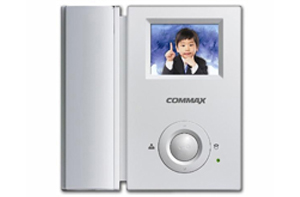 Video door entry consists of both outside and indoor elements: a outdoor panel on the outside, an electronic lock release and an indoor monitor. The outdoor panel or street panel is installed beside the entrance door or gateway and incorporates different elements ready for use in any climate conditions: one or several pushbuttons to make the call (usually one per home or apartment), a micro camera adapted for night vision to capture the image of the caller, a microphone to pick up their voice and a speaker to reproduce the voice of the occupant indoors.
Video door entry consists of both outside and indoor elements: a outdoor panel on the outside, an electronic lock release and an indoor monitor. The outdoor panel or street panel is installed beside the entrance door or gateway and incorporates different elements ready for use in any climate conditions: one or several pushbuttons to make the call (usually one per home or apartment), a micro camera adapted for night vision to capture the image of the caller, a microphone to pick up their voice and a speaker to reproduce the voice of the occupant indoors.
A video door entry panel may include pushbuttons to call the homes or offices and a camera to capture the street scene. The video entry monitor allows the occupant to see who has called, talk to the visitor and open the door. Installed indoors, the monitor consists of a screen showing the image of the person calling, a microphone and earpiece for conversation for conversation and a pushbutton to trigger the door lock release. The communication set up is full duplex. The electric door release is a device installed in the door lock and operated from inside the building to lift the latch and clear the way for the visitor.
There are several variations on this basic format. In addition to outdoor panels with one pushbutton per apartment, it is possible to find others with a numeric keypad: in this case, designed for large residential installations, the homes are identified by codes. Others have built-in cardholders panels or even small screens to guide the user or facilitate entry for people with disabilities. Some video entry monitors have an earpiece similar to a telephone handset, while others are "hands-free". Other examples are monitors with memories which store an image every time someone calls at the door or touchscreen video entry systems.
When a visitor presses one of the outdoor panel pushbuttons, the built-in camera is connected and the image captured outdoors appears on the monitor screen. Connection takes place automatically with no need to activate the equipment, which is one of the essential elements of video door entry. As of this point, the person inside the building can open the door if they wish or begin a conversation, which is usually secret (cannot be heard by other users of the same facility). The equipment also disconnects automatically after a set time has elapsed. The video entry system as a whole runs on low voltage energy from the building's trunk power supply separately from the in-house installation, so the equipment can be used even if power in a home has been cut off.
Many terminals currently on the market are ready to accept extensions, making the monitor into a small automatic function control centre. From here, the user can view one or several additional cameras installed at other access points, trigger light switches or open a second door, etc.